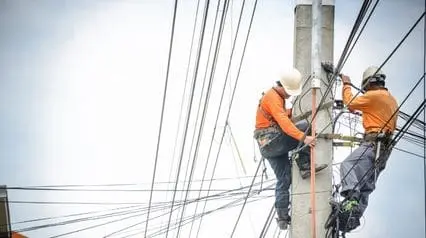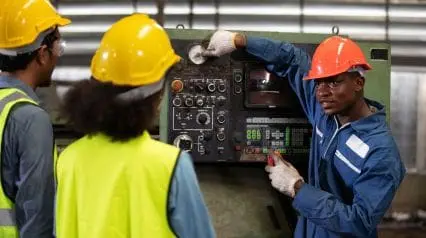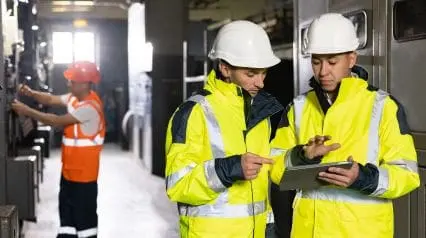What is Power Line Safety?
Power line safety is understanding the dangers associated with power lines and taking steps to avoid them. Companies have a responsibility to maintain their power lines and educate the worker and their staff about electrical hazards and how to be safe. Meanwhile, the workers are also responsible for being aware of the dangers of power lines and taking precautions to avoid them.
Power lines are a necessary part of our electric grid, but they can also be extremely dangerous. Every year, there are accidents involving power lines that result in serious injury or even death. This is why power line safety is a vitally important issue for both utility companies and the general public.
The Importance of Power Line Safety
Power lines can be extremely dangerous because they carry high voltages of electricity. If you come into contact with a power line, you could be seriously injured or even killed.
According to the Electronic Library of Construction Occupational Safety and Health (elCOSH), power lines come in second for the cause of electrocutions to electrical workers and other construction workers in the US. That’s why it’s important to stay clear of power lines and to avoid activities that could put you in direct contact with them.
What Are the Hazards and Injuries Associated with Power Lines?
There are many hazards and injuries associated with power lines. The most common electrical injuries are electrical burns, which can occur if someone comes into contact with a live power line. This can happen if someone climbing a tree or pole hits a power line or if someone tries to repair a power line without proper training or equipment. Electrocution can also occur if someone tries to steal copper wire from a power line.
Other injuries associated with power lines include the following:
- Burns can occur if someone comes into contact with a power line or is hit by falling debris from a power line.
- Falls can occur if someone tries to climb a power line or is working on a power line and lose their balance.
- Traumatic brain injuries can occur if someone gets hit by falling debris from a power line or if they are involved.
Power Line Safety Tips
Electrical power lines are vital infrastructure for countries worldwide, as they deliver electricity from power plants to our homes and businesses. While power lines are safe when they are well-maintained, there are some safety hazards that you should be aware of and safety guidelines to follow.
Here are some electrical safety tips to follow around power lines:
- Never climb trees near power lines.
- If you see someone who is in contact with a power line, do not touch them. Call 911 immediately.
- Never touch a power line with your bare hands or with any conductive object.
- Never touch anything that is touching a power line, such as a ladder, pole, or tree.
- Keep a safe distance from power lines. Power lines are usually marked with danger signs. The safe distance depends on the voltage of the power line.
- In case of wet areas, make sure that no power line has fallen to the ground. If there is, do not touch them or even go near them.
- Always wear proper Personal Protective Equipment (PPE) when working around power lines.
Digitize the way you Work
Empower your team with SafetyCulture to perform checks, train staff, report issues, and automate tasks with our digital platform.
Get Started for FreeSafety Equipment To Wear Near High Voltage Power Lines
In recent years, power line safety has become a major concern for businesses and municipalities around the world. Power lines are a vital part of their infrastructure but can also pose risks to everyone’s safety if not properly maintained.
To reduce the risk of electrocution, it is essential to wear the proper PPE equipment when working with power lines. Below are some PPE essentials for power line safety:
- Safety glasses
- Face shields
- Hard hats
- Insulated boots
- Rubber gloves with leather protectors
- Insulating sleeves
- Flame-resistant clothing
FAQs about Power Line Safety
There are two main types of power lines: overhead and underground. Overhead lines are the most common, and they’re the kind you’re probably familiar with. They’re the ones that run from poles to your home or business. Meanwhile, underground lines are buried beneath the ground and are usually found in commercial and industrial areas.
An establishment should at least have a distance of 200 meters from a high-voltage power line. More specifically, according to the Occupational Safety and Health Administration (OSHA), the minimum distances from power lines are as follows:
- For less than 200 to 350 volts – a distance of 20 feet (6.10 meters)
- For 350 to 500 volts – a distance of 25 feet (7.62 meters)
- For 750 to 1,000 volts – a distance of 45 feet (13.72 meters)
The people at risk of electrical hazards from power lines are the workers who are constantly exposed to and work with them, such as:
- Construction laborers
- Plasterers
- Brick masons
- Carpenters
- Painters, and
- Electricians
Though it may cause injuries, there is no evidence that power lines are harmful to a person’s health. Still, it pays to follow safety precautions when working with power lines to keep yourself safe and avoid potential injuries.
When working with electrical hazards, especially those with high voltage capacities, it is recommended to:
- Wear proper PPE attire at all times.
- Adhere to proper safety guidelines while working.
- Avoid touching equipment parts with high-voltage terminals and outputs.
- Avoid using tools that you’re not familiar with or trained for.
- Closely communicate with your team during power line operations.



